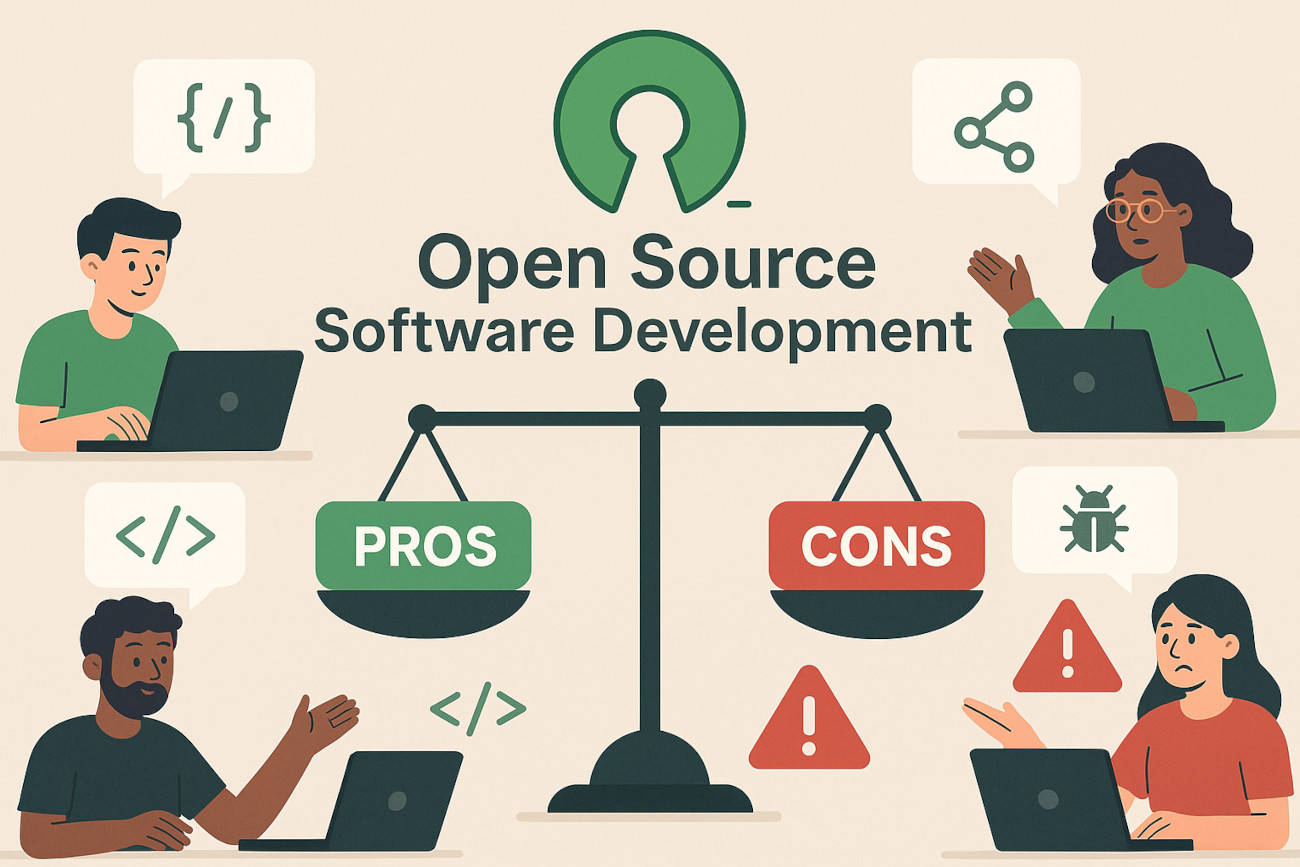Open Source Software Development: The Pros and Cons
|
|
Open source software (OSS) has fundamentally altered the way software is built, distributed, and used. Thus, reshaping the modern technology landscape. OSS is at the heart of countless innovations, from the operating systems that power servers to the libraries that drive artificial intelligence (AI). However, like any approach, open source development comes with unique advantages and challenges.
| Key Takeaways: |
|---|
|
In this article, we will learn the following:
|

What is Open Source Software?
Open source software has source code that anyone can inspect, modify, and enhance.
It is a revolutionary concept in software development and has changed how software is developed and distributed. In OSS, anyone can contribute to creating, updating, or enhancing the software. The developers who contribute to OSS are called contributors. It is developed collaboratively and typically available freely under licenses that comply with the Open Source Definition, such as the Apache License, GNU General Public License (GPL), or MIT License.
OSS Key Features
Here are the main features of OSS:
- OSS is a free software product
- Developers have access to the source code of OSS
- Developers can add features, fix bugs, or enhance software’s performance
- All users of the software benefit from the modifications made to the software
- OSS saves cost, improves security, and increases innovation
Then there is proprietary software or closed-source software whose code is controlled by the company and can be modified only by the code owners. This is in contrast to OSS, which promotes community collaboration, decentralization, and transparency.
Popular proprietary software examples include products from Apple, Adobe, and Microsoft.
The idea of OSS development stems from the shared code, which was a norm in the earliest days of computer programming, particularly in academia. It is picked up from the longstanding tradition of free and open knowledge exchange.
Most OSS use the copyleft philosophy, which states that all modifications (additions, updates) to the software must be released under the same license. Most software companies have started using OSS as the main component of their development. IT giants like Microsoft, IBM, Google, and Apple have all implemented open-source solutions in their products and services.
OSS Examples
The following table shows some examples of OSS solutions and vendors:
| Open Source Solutions Examples | Open Source Vendors Examples |
|---|---|
|
|
Some companies use OSS as a norm, while others stick to proprietary software. Open-source software (OSS) offers a range of benefits, including flexibility, reduced cost, and community-driven development. Still, it also presents challenges like a lack of dedicated support, potential security vulnerabilities, and compatibility issues. Using OSS or proprietary software depends on a particular organization’s specific needs and priorities.
The Pros of Open Source Software Development
The benefits of using OSS development are as follows:
1. Transparency and Trust
In OSS, the source code is accessible to users, who can see how the software operates under the hood. Users or contributors can verify that the software doesn’t have malicious code, backdoors, or privacy-invading features. This transparency builds trust, especially in industries with strict security standards and compliance requirements, like financial institutions.
The developers’ community can review this publicly available source code and identify potential vulnerabilities.
2. Community Collaboration and Innovation
Community is one of the distinguishing features of OSS. It builds and maintains the OSS, leading it to rapid innovations as contributors worldwide share their knowledge, fix errors, and propose features. For example, OSS like Linux and Kubernetes flourish because of their massive, global collaboration. Also, their large contributors’ community is very active, and they provide prompt assistance and support.
3. Cost Effectiveness
Most OSS is free to use, significantly reducing business and individual costs. It has become easier for startups and nonprofits to access high-quality software without expensive licensing fees and financial burdens.
Companies can allocate these saved funds to customization and customer support to enhance their value further. Read: Why Startups Fail at Testing and How to Fix it.
4. Flexibility and Freedom
With OSS, contributors have freedom to modify the code as per their requirements. Contrary to proprietary software that limits the usage or customization of code, OSS offers flexibility to tailor the code to different use cases, integrations, or environments. This flexibility and freedom is particularly beneficial for organizations that require niche solutions or are required to maintain control over their technology stack.
For example, organizations using Git OSS have the flexibility to customize the repository as per their requirements and are free to extend it.
5. Security and Reliability
As per Linus’s law, “Given enough eyeballs, all bugs are shallow”.
This fits perfectly with OSS. With many eyeballs on the code, risks and vulnerabilities can be spotted and fixed more quickly. The open nature of software allows for adaptations and modifications to meet specific needs.
For example, OSS such as OpenSSL, PostgreSQL, and NGINX have high reliability for long term testing and community scrutiny. Read: Security Testing.
6. Avoiding Vendor Lock-In
With proprietary software, users are dependent on the vendor’s roadmap, pricing, support, and terms. If any of these services provided by the vendor expires or is not renewed, vendor lock-in sets in, that may cause inconvenience to developers.
OSS frees organization of these dependencies, offering flexibility to fork, migrate, or maintain the software independently. This helps organizations with long-term sustainability and technological autonomy.
7. Learning and Career Growth
OSS is a powerful tool for career development and learning. Contributors and developers can study various real-world projects, contribute to open source communities, and build their professional portfolios. Since open source is a large community, the effort put in by contributors are noticed, and many have even launched their careers based on open source contributions.
Additionally, with many experienced contributors around the world, it also creates a culture of mentorship, feedback, and knowledge sharing that can supplement one’s professional growth.
The Cons of Open Source Software Development
OSS development has several disadvantages as follows:
1. Lack of Official Support
Many OSS such as Git, Kubernetes have vibrant communities and offer quick support. However, not all OSS projects have active communities and formal support that enterprises expect. Unlike commercial vendors with dedicated help desks, OSS projects have to rely on forums or volunteers for help. Read: What are Docker and Kubernetes and why do I need them?
Critical systems that need guaranteed uptime or rapid response may be at risk because of this lack of official support.
2. Fragmentation and Inconsistency
OSS projects can be forked or diverged flexibly and may lead to fragmentation. This may result in further confusion, compatibility issues, or even disagreements and competition within the community. Long-term stability of the project may be affected by inconsistent documentation, varied code quality due to too many contributors, and lack of unified vision.
For example, as of now, the Linux ecosystem has too many distributions like Ubuntu, Fedora, Arch, and so on that often complicate support and interoperability.
3. Steep Learning Curve
OSS projects are built by developers for developers, hence they lack intuitive design or user-friendliness. The configuration, installation, and maintenance requires significant technical know-how. Without skilled IT staff, it may be difficult for organizations to adapt to the OSS.
In addition, some OSS projects are complex to use, especially if they do not have user-friendly interfaces or are command-based. For example, OpenSSL is mostly command-based, and requires technical knowledge of libraries, commands to work with it.
This results in a steep learning curve for users when adapting OSS.
4. Hidden Costs
Although the software is free, there are many other actions such as integration, customization, training, documentation,support, and security audits that incur hidden costs. Apart from these costs, enterprises have to hire developers to maintain and adapt the software, resulting in additional costs. In some cases, like Red Hat for Linux, commercial support contracts are also necessary.
5. Governance and Decision-Making Challenges
OSS is a free community and may lack leadership and direction. This may give rise to internal conflicts, slow decision-making, or even abandonment, due to a lack of clear governance. Power dynamics may create bottlenecks with a single maintainer controlling critical changes.
6. Security Risks Due to Neglect
The OSS model promotes transparency but is also dependent heavily on active maintenance. If a project is poorly maintained or loses contributors, risks and vulnerabilities may go undetected for extended periods. Moreover, these vulnerabilities may be exploited for malicious purposes, which heightens security risks. An infamous example of this is the Heartbleed bug in OpenSSL that surfaced because of underfunding and a lack of oversight.
7. License Compliance Issues
Understanding and adhering to OSS licensing requirements can be complex. Many organizations may also misuse licences, knowingly or unknowingly, and fail to comply with redistribution clauses, disclosure, or attribution. Such non-compliance can expose businesses to legal risks or force open sourcing of proprietary code.
Real-World Examples of OSS
Let us have a look at the real-world success stories and a few challenging projects.
OSS Success Stories
Here are some examples of OSS success stories:
- Linux: Currently powers most web servers and is a cornerstone of cloud computing. It has been a very successful OSS project and has millions of users globally.
- Apache HTTP Server: One of the most widely used web servers globally across devices and platforms. It has only grown stronger as time passed.
- MySQL/PostgreSQL: These are open-source database systems powering thousands of applications globally, including cloud applications.
- Python: Widely used open-source programming language with a rich ecosystem of libraries and features that powers AI systems.
- Firefox: Mozilla’s browser continues championing open web standards through open source.
Challenges in the Wild
However, some OSS projects were challenging:
- OpenSSL (pre-Heartbleed): This project was maintained by a tiny team but used globally.
- LibreOffice vs. OpenOffice: This fork was created due to governance and innovation disagreements.
- Log4j Vulnerability (Log4Shell): Log4Shell is a widely used logging library but a critical bug exposed the fragility of underfunded yet essential OSS infrastructure.
The Future of Open Source
The future of OSS lies in improved governance models, more equitable contributor recognition, and better sustainability. Some emerging trends include:
- Open Core Business Models: Companies offering free OSS with paid enterprise features.
- Developer Sponsorship Platforms: Various sponsorship programs like GitHub Sponsors, Open Collective, and Patreon allowing users to support maintainers financially.
- Foundation-Led Stewardship: Neutral organizations helping manage large projects to avoid conflicts of interest (e.g., CNCF for Kubernetes).
- AI and Automation: Tools like GitHub Copilot are accelerating contributions and code quality for OSS.
Conclusion
OSS development empowers innovation, lowers costs, and encourages global collaboration. At the same time, it also introduces complexity, risk, and unpredictability. For developers and contributors, it provides a gateway to the community, learning, and creativity. For businesses, OSS provides a powerful toolset with careful strategy, investment, and governance.OSS success depends on a healthy ecosystem where contributors are valued, users are well-informed, and software is well-maintained.
With these measures, OSS can be a cornerstone of technological innovation and digital progress.
| Achieve More Than 90% Test Automation | |
| Step by Step Walkthroughs and Help | |
| 14 Day Free Trial, Cancel Anytime |












